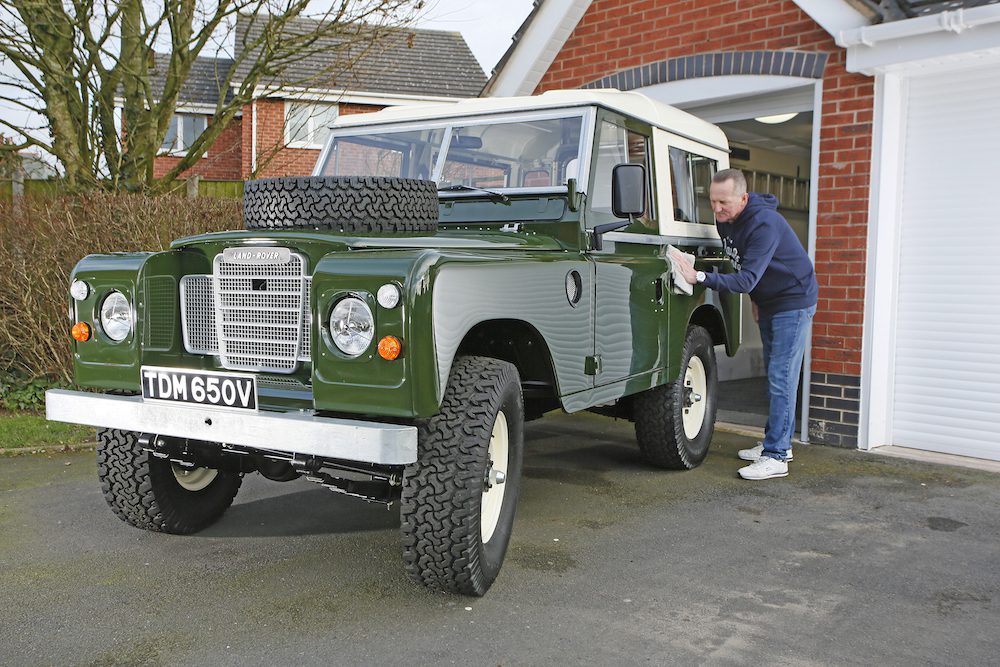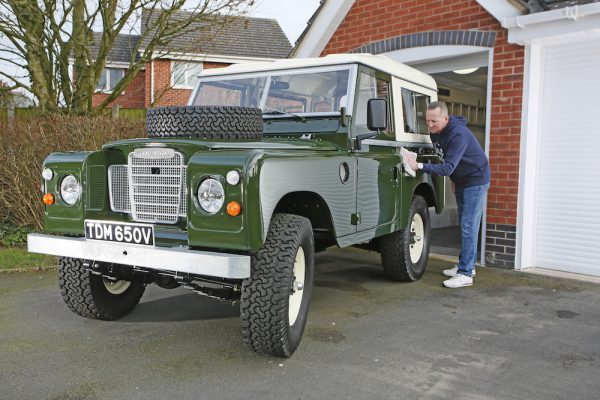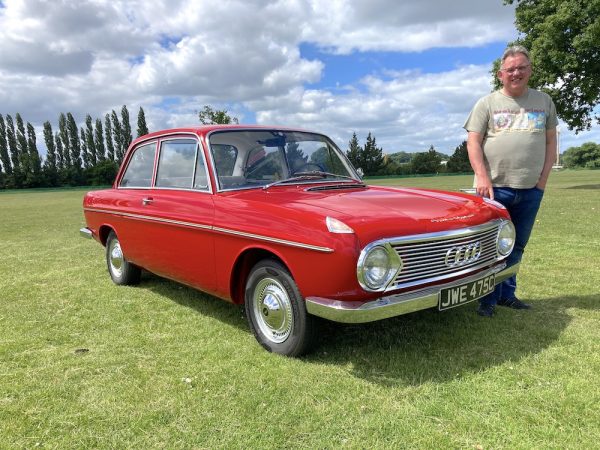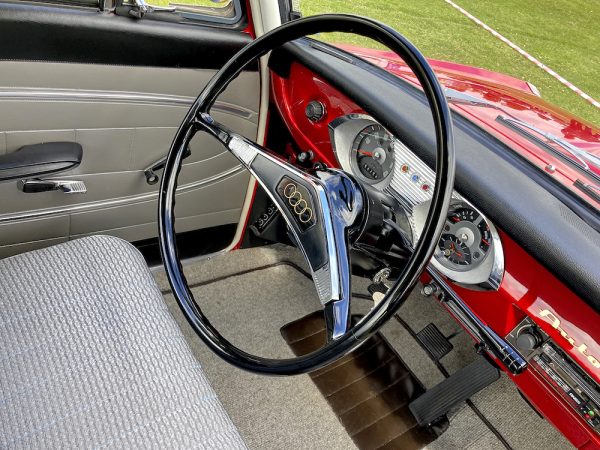Is this the best Land Rover restoration you’ve ever seen?

Fresh from the pages of Practical Classics Magazine, we meet Steve Brown, who spent years restoring his Land Rover Series 3 into prime condition, and Paul Collins, who has been converting his Fiat 1500 for the last 31 years.
As a specialist classic car insurance broker, we love seeing old cars being restored to their former glory, which is why we’ve linked up with Practical Classics to bring you two fantastic stories each month for you to digest and take as inspiration for your own classic rebuilds.
One of the best Land Rover restorations you’ll ever see
Words by Matt Tomkins and Pictures by Tom Critchell
In March 2014, while looking for an old British motorbike to restore, Steve Brown stumbled across an immensely forlorn-looking Land Rover Series 3 and, glancing across at his wife, received the firm instruction ‘don’t you dare!’ But eight years on, that very same pile of scrap is now a true work of art; resplendent in stunning bronze green, the underside just as perfect as the top, as Steve opens his garage door and rolls it out into the sunshine.
It is arguably better than the day it left the factory. If you’ve been following Practical Classics’ Rebel with a Cause project, then Steve’s name will likely be familiar to you. Steve is the perfectionist genius who, in a matter of just a few days, prepared and painted that fibreglass shell to an amazing standard in time for it to be unveiled and reassembled live at the Practical Classics Classic Car and Restoration Show at the NEC in March.
The finish on the Rebel is amazing, but this Land Rover, completed to Steve’s own exacting standards without the pressure of a curtain call just weeks after taking the project on, exemplifies exactly what he can really do given the opportunity. Steve works for HB Body, who manufacture and supply a wide range of automotive refinishing products, as a technical manager – answering paint shop and private individuals’ questions about how to get the best from his company’s products. So he can talk the talk, but boy is this Land Rover testament to the fact that he can walk the walk as well.
The rotten 88-inch Series 3 had been festering, unknown to Steve, in a barn just a mile from his house since the early nineties, but from the moment Steve laid eyes on it he saw the potential. “I originally intended to buy it as a doer-upper and move it on quickly” admits Steve. “But as soon as I discovered just how bad it was, I realisedI was in this for the long haul.”
Having got the Land Rover home, Steve got to work, stripping it into manageable parts. “With the rear tub off, it quickly became apparent the chassis would need replacing” recalls Steve, who put his fist through the chassis in several places while assessing the extent of the corrosion. “I was originally just going to do it up and keep it scruffy, but when the new chassis was sitting in my garage I couldn’t bring myself to bolt anything less than perfect back to it.”
Steve dismantled the Land Rover down to every last nut and bolt and put the panels into storage so he had space to work in his garage at home. Knowing how long these jobs take, the first job on Steve’s list was to call round and find someone who could tackle the engine work. Having found a specialist who sounded promising, the engine too left the garage, but six months later it still hadn’t been touched – and it was the same story with the second specialist entrusted to carry out the required works.
After a frustrating year, Steve found Bradbury Engineering just a few miles away from his home, who quickly stripped and assessed the tired lump. “I knew it was being done properly this time, but I couldn’t be completely hands off.”
Once the block was stripped and all the machining work was complete, Steve took a boot full of components home to thoroughly clean and repaint to an incredible standard. “The boys at the rebuilders didn’t want to touch the parts when I delivered them back” Steve chuckles. “They usually have to wear gloves to keep dirt from the engines off their hands, not the other way around!”
While the engine work was underway, Steve prepared and painted his new chassis in satin black before stripping the axles down to their bare casing and sending them for blasting. Once back, it was out with the paint gun once again before the newly shiny axles could be rebuilt.

Piece by piece, the Land Rover’s rolling chassis took shape. New springs and bushes supported the axles with replacement stainless fixings used throughout. When the engine came back from reconditioning, it dropped straight into the chassis, once mated to the cleaned and re-sealed gearbox, as the jigsaw slowly came together.
Considering the state of the chassis, it’s somewhat of a miracle that, after it had been blasted back to bare steel, only the footwells required replacement before Steve could apply several coats of epoxy primer in his garage at home before transporting it to a friend’s paint shop to apply the first bronze green of the project.
“Luckily, I visit a lot of body shops for my job and have formed good relationships with a number locally. Alan Sutton of Creative Coachworks, Lee Reynolds from Longmynd Service Station, Dave at Roden Garage and Mark from MLM Coachworks Bletchley, who actually put me on to the car in the first place, all allowed me to bring prepped and primed panels into their body shops at various points throughout the restoration for me to apply the top coats under proper conditions. I’m really grateful for their help, as without it there is no way I could have produced a result that I would have been happy with.”
With the bulkhead safely home, it was fitted to the rolling chassis and presented itself as a blank canvas for Steve to build upon. Years of evenings and weekends spent locked in the garage followed, with Steve stripping, cleaning, repairing, and painting even the smallest components. Everything you see under the bonnet, right down to the original brown wiring grommets, which have been meticulously cleaned, is original to the car, barring the heater unit which was completely rusted through and home to a family of mice when Steve took the project on. “I didn’t want to just throw it all away and build a new car from a catalogue. That’s not in the spirit of restoration. I get so much more pleasure from seeing people’s faces when I pop the bonnet and am able to say ‘I did that’ rather than ‘I bought that’.”
One by one, Steve pulled the body panels out of storage and set to work stripping, repairing, filling, priming and finally painting them one-by one, not forgetting the endless test fitments of each and every component so as to ensure there would be no paint damage when the time came to reassemble the car. While trial fitting the doors and rear tub to ensure perfect panel gaps, Steve couldn’t stop looking at the pock marks that aluminium corrosion had left in the rear tub floor.
Once all the dirty jobs had been completed, and the panels were all either primed or in paint, Steve took a break from the Land Rover to focus on his garage. “I didn’t want to be working with new parts in a filthy environment, so I completely gutted the garage, had the walls plastered and a radiator put in as well as carpet and decent LED lighting throughout. It meant that when I started the reassembly, it was in a clean environment which was a pleasure to work in.”
The major reassembly work began in earnest in December 2020, with Steve’s new, warm, garage the perfect environment to hide himself away in over long winter evenings. Steve’s meticulous preparation paid off and piece by piece the Land Rover came together, perfect in every last detail.
Steve finished his Land Rover just in time for the 2021 Classic Motor Show where it took pride of place on the HB Body stand. “I’ve been involved with a lot of restorations in my life, both professionally and with friends, but this is the first which I have seen through completely myself, every nut, bolt and screw. I’m quite proud of that.”
Read the full version of how Steve managed to restore his Land Rover on the Practical Classics page.
The DKW transported from northern Sweden, beautifully restored in Paul’s garage
Words and Pictures by Danny Hopkins

When Paul Collins came across an advert for an ultra-rare DKW model, he knew he had to buy it and restore it to its former glory. The only issue was he had to transport it from Sweden, as he explains:
Sometimes you just have an affinity with a marque… that happened with me and DKW. This was the final DKW model that the company made before it became Audi as we know it today and the engines went from two- to four-stroke. I’ve owned it for six years. It has a 1200cc three-cylinder two-stroke engine and I’ve just finished restoring it myself in my garage in Hull.
The car was advertised on a Swedish website called Blocket and was in Sweden, which is why it’s left-hand drive. It had been stored in a garage for ten years. I went with my Swedish friend Frederick Folkstan to pick it up and then I drove it carefully to Gothenburg. We put it on the ferry to Immingham, where I picked it up.
It needed quite a bit of bodywork, so I stripped it and I put the bare shell on a spit to do the welding, which helped. I also had to fabricate many body parts myself. The interior was bad, really bad. I had to make the headlining and also re trimmed the seats myself. Everything inside was restored, the seats resembled something from the Addams Family, the cloth was so threadbare. I ended up having new cloth manufactured in America for the seat as I couldn’t find anything remotely near the original here. This took more than a year.
The door cards had discoloured badly due to the sun, so I recoloured all the vinyl using vinyl paint from Colorlock in the Midlands, which is a fantastic product. I also re-carpeted the entire interior. Luckily it isn’t as difficult to find parts as it used to be because the Dutch club has invested a lot of time buying parts from all over Europe and storing them in a warehouse.

I’ve restored quite a few DKW’s over the years, so I knew where to get the bits. I was as organised and methodical as I had been in previous restorations and, thankfully, most of the work went to plan.
The engine needed a complete rebuild as number three piston was missing the top ring and the pin that held the top ring had become loose and worked its way through the crown of the piston. In the process it had heavily scored the bore to the point that it was beyond a rebore.
I ended up having to get another block and pistons from Holland and also had the crank rebuilt. The only real nightmare occurred after it came back from the specialist. When I came to fit the crank a year later, one of the bearing faces wasn’t right, so I had to send it to Holland for another rebuild.
The first car I ever owned was a DKW. My father bought one secondhand, imported from Holland. They did sell it in the UK, but not many were sold in total. The F102 will cruise on the motorway at 70mph all day, and they like being revved. I can’t wait to do that in this one – It’s a show car and a user, and I can pretty much guarantee you won’t see another one… unless you are on a run with the DKW club that is.
Read the full version of how Paul managed to restore his DKW on the Practical Classics page.







